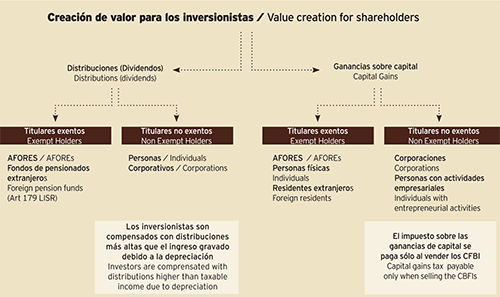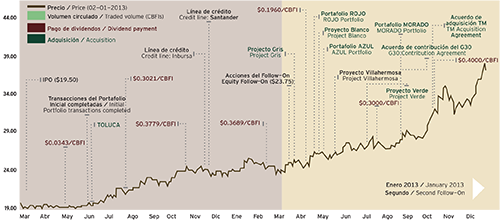Español
Atracción de inversión para grandes portafolios
Cuenta con cerca de 3,000,000 m2 en espacio rentable y más de cinco billones de dólares de valor de capitalización. Es el primer y más grande Fideicomiso de Inversión en Bienes Raíces (FIBRA) que cotiza en la Bolsa Mexicana de Valores (BMV), lanzado en 2011.
Surgimiento
El equipo fundador de FIBRA Uno se ha dedicado, a lo largo de cuatro décadas, a la adquisición, desarrollo, alquiler y operación de activos inmobiliarios industriales, comerciales, turísticos, de oficinas y uso mixto en México.
Esa experiencia fue un factor clave en la composición y lanzamiento del primer Fideicomiso de Inversión en Bienes Raíces, FIBRA Uno o FUNO, como se le conoce por su clave de pizarra en la Bolsa Mexicana de Valores (BMV).
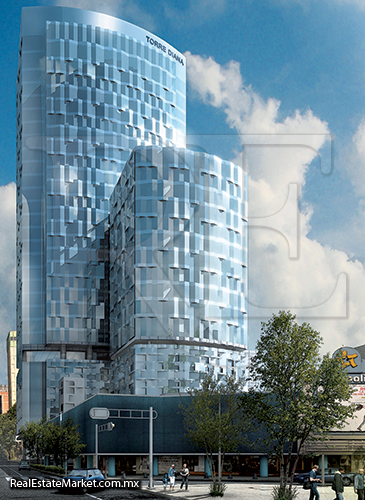
El comienzo de sus actividades inmobiliarias se remonta a la década de 1970, cuando sus accionistas mayoritarios se enfocaron al negocio inmobiliario a partir de la necesidad de adquirir propiedades bien ubicadas, que se apegaran a sus estándares de calidad y ofrecieran un alquiler razonable para apuntalar su franquicia de pinturas.
En los años 1980 comenzaron a adquirir y desarrollar terrenos aprovechando la necesidad de construcción de espacios comerciales adicionales para ser arrendados a otros negocios. Al detectar esa oportunidad en dicho sector, se produjo un cambio en su visión empresarial, enfocándose al negocio inmobiliario y ampliando su cartera de propiedades.
A principios de la década de 1990 construyeron su primera instalación industrial y de esta manera iniciaron su expansión a otros sectores como el turístico, de oficinas y usos mixtos en la industria inmobiliaria del país.
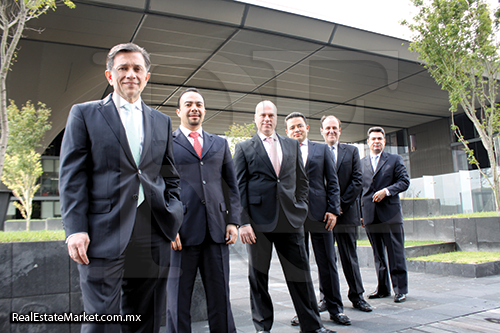
El equipo de administración de Fibras Uno/Gonzalo Robina, Gerardo Del Ángel, Javier Elizalde
Eleazar Pulido, Ignacio Tortorielo, Jesús Estrada.
Aprovechando toda la experiencia de esta trayectoria, en 2010 conformaron la estructura de FUNO, la primera en su tipo de México en lanzar una Oferta Pública Inicial (Initial Public Offering, IPO por sus siglas en inglés) en la Bolsa Mexicana de Valores bajo el régimen Fideicomiso de Inversión en Bienes Raíces (FIBRA) el 18 de marzo de 2011.
Esta oferta se lanza con la adquisición de 16 inmuebles en el portafolio, todos rentados y sin deudas. De éstos, 14 fueron contribuidos, es decir aportados al Fideicomiso a cambio de Certificados Bursátiles Fiduciarios Inmobiliarios o CBFI, y dos adquiridos con el capital generado por medio de la oferta pública.
Su estructura está basada en un portafolio diversificado de propiedades estratégicamente ubicadas y destinadas al arrendamiento. Abarca una amplia gama de sectores inmobiliarios en México como el industrial, comercial, turístico, de oficinas y uso mixto, con excepción del residencial. A través de estas rentas, se generan ingresos para los inversionistas que han adquirido sus CFBI, haciendo a este instrumento muy atractivo para cualquier inversionista.
| • Portafolio azul (MEXFUND) Noviembre de 2011 | ||||||||||||||||||||||||
|---|---|---|---|---|---|---|---|---|---|---|---|---|---|---|---|---|---|---|---|---|---|---|---|---|
| Propiedad: Hermosillo Tipo: Industrial Entidad: Sonora |
Propiedad: UVM Zapopan Tipo: Comercial Entidad: Jalisco |
Propiedad: Reforma 222 Tipo: Oficinas Entidad: Distrito Federal |
Propiedad: Terraza Pedregal Tipo: Comercial Entidad: Distrito Federal |
Propiedad: Aguascalientes Tipo: Comercial Entidad: Aguascalientes |
Propiedad: Acapulco Tipo: Comercial Entidad: Guerrero |
Propiedad: Olivar de los Padres Tipo: Comercial Entidad: Distrito Federal |
Propiedad: Alameda Tipo: Comercial Entidad: Distrito Federal |
Propiedad: Naucalpan I Tipo: Comercial Entidad: Estado de México |
Propiedad: Tijuana Tipo: Comercial Entidad: Baja California |
Propiedad: Mexicali Tipo: Comercial Entidad: Baja California |
Propiedad: Miguel Ángel de Quevedo Tipo: Comercial Entidad:Distrito Federal |
Propiedad: Santa Fé Tipo: Comercial Entidad: Distrito Federal |
Propiedad: Arboledas Tipo:Comercial Entidad: Estado de México |
Propiedad: Monterrey Tipo: Comercial Entidad: Nuevo León |
Propiedad: Cofre de Perote Tipo: Comercial Entidad: Distrito Federal |
Propiedad: Edison Insurgentes Tipo: Comercial Entidad:Distrito Federal |
Propiedad: Del Valle Tipo: Comercial Entidad: Distrito Federal |
Propiedad: Yucatán 23 Tipo: Oficinas Entidad: Distrito Federal |
Propiedad: Tlahuac Tipo: Oficinas Entidad: Distrito Federal |
Propiedad: Leones Tipo: Oficinas Entidad: Distrito Federal |
||||
|
|
 |
 |
 |
 |
 |
 |
 |
 |
 |
 |
 |
 |
 |
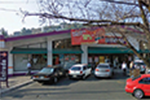 |
 |
 |
 |
 |
 |
 |
||||
| • Portafolio rojo (SANTANDER) Abril de 2012 | ||||||||||||||||||||||||
|---|---|---|---|---|---|---|---|---|---|---|---|---|---|---|---|---|---|---|---|---|---|---|---|---|
| Propiedad: Reforma Tipo: Comercial Entidad: Distrito Federal |
Propiedad: Américas Tipo:Oficinas Entidad: Guadalajara |
Propiedad: Santa Fé Tipo: Oficinas Entidad: Distrito Federal |
Propiedad: Site Periférico Sur Tipo:Oficinas Entidad:Distrito Federal |
Propiedad: Periférico Tipo: Oficinas Entidad: Distrito Federal |
Propiedad: mérida Tipo: Comercial Entidad: Yucatán |
Propiedad: Av. Reforma Tipo: Comercial Entidad: Distrito Federal |
Propiedad: Monte Elbruz Tipo: Comercial Entidad: Distrito Federal |
Propiedad: Mazarik Tipo: Comercial Entidad: Distrito Federal |
Propiedad: insurgentes Sur Tipo: Comercial Entidad: Distrito Federal |
Propiedad: Ruiz Cortines Tipo: Comercial Entidad:Distrito Federal |
Propiedad: Bosques del Valle Tipo: Comercial Entidad: Nuevo León |
Propiedad: Jose Vasconcelos Tipo: Comercial Entidad: Nuevo León |
Propiedad: C. Doblado Tipo: Comercial Entidad: Nuevo León |
Propiedad: Blvd. Interlomas Tipo: Comercial Entidad: Estado de México |
Propiedad: Lomas Verdes Tipo: Comercial Entidad: Estado de México |
Propiedad: Palmas Tipo:Comercial Entidad: Distrito Federal |
Propiedad: Benito Juárez Tipo: Comercial Entidad: Sonora |
|||||||
 |
 |
 |
 |
 |
 |
 |
 |
 |
 |
 |
 |
 |
 |
 |
 |
 |
 |
|||||||
| • Portafolio morado (GICSA) Agosto de 2012 | ||||||||||||||||||||||||
|---|---|---|---|---|---|---|---|---|---|---|---|---|---|---|---|---|---|---|---|---|---|---|---|---|
| Propiedad: Tultitlán I Tipo: Industrial Entidad:Estado de México |
Propiedad: Tultitlán II Tipo: Industrial Entidad: Estado de México |
Propiedad: Tlanepantla Tipo: Industrial Entidad: Estado de México |
Propiedad:Outlet Tipo:Comercial Entidad:Guadalajara |
Propiedad: Outlet Monterrey Tipo:Comercial Entidad:Nuevo León |
Propiedad: Forum Tepic Tipo:Comercial Entidad: Nayarit |
Propiedad: La isla Tipo:Comercial Entidad:Quintana Roo |
Propiedad: Forum by the Sea Tipo:Comercial Entidad:Quintana Roo |
Propiedad: Punta Langosta Tipo:Comercial Entidad:Quintana Roo |
Propiedad: Centro Maya Tipo:Comercial Entidad:Quintana Roo |
Propiedad: Outlet Cancún Tipo:Comercial Entidad:Quintana Roo |
Propiedad: Punta Santa Fe Tipo:Oficinas Entidad:Distrito Federal |
Propiedad: Corporativo Insurgentes Tipo:Oficinas Entidad:Distrito Federal |
Propiedad: Corporativo Interlomas Tipo:Oficinas Entidad:Estado de México |
Propiedad: Edificio Monterrey Tipo:Oficinas Entidad:Nuevo León |
Propiedad: Corporativo Polanco Tipo:Oficinas Entidad:Distrito Federal |
|||||||||
 |
 |
 |
 |
 |
 |
 |
 |
 |
 |
 |
 |
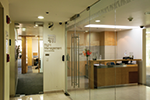 |
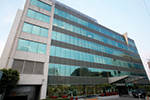 |
 |
 |
|||||||||
| Portafolio G30 Diciembre de 2012 | ||||||||||||||||||||||||
|---|---|---|---|---|---|---|---|---|---|---|---|---|---|---|---|---|---|---|---|---|---|---|---|---|
| Propiedad: San Martín Obispo I Tipo:Industrial Entidad:Estado de México |
Propiedad: San Martín Obispo II Tipo:Industrial Entidad:Estado de México |
Propiedad: Tlane-Park Tipo:Industrial Entidad:Estado de México |
Propiedad: Tlane-Park II Tipo:Industrial Entidad:Estado de México |
Propiedad: Tulti-Park Tipo:Industrial Entidad:Estado de México |
Propiedad: Iztapalapa Tipo:Industrial Entidad:Distrito Federal |
Propiedad: La Joya III Tipo:Industrial Entidad:Estado de México |
Propiedad: La Joya IV Tipo: Industrial Entidad:Estado de México |
Propiedad: James Watt Tipo:Industrial Entidad: Estado de México |
Propiedad: Puente Grande Tipo:Industrial Entidad:Estado de México |
Propiedad: Maravillas II Tipo:Industrial Entidad:Estado de México |
Propiedad: La Mexiquense Tipo: Industrial Entidad: Estado de México |
Propiedad: Las Américas Tipo: Industrial Entidad: Qintana Roo |
Propiedad: La Purísima Tipo: Industrial Entidad: Estado de México |
Propiedad: Ceylan Tipo: Industrial Entidad: Estado de México |
Propiedad: Gustavo Baz Tipo:Industrial Entidad:Estado de México |
Propiedad: Tecno Parque Berol Tipo:Industria Entidad: Estado de México |
Propiedad: Centro Lago de Guadalupe Tipo:Comercial Entidad:Estado de México |
Propiedad: Pabellón Salinas Cruz Tipo:Comercial Entidad:Oaxaca |
Propiedad: Torre Latino Tipo:Oficinas Entidad:Distrito Federal |
Propiedad: Torre Platino Tipo:Oficinas Entidad:Distrito Federal |
Propiedad: Torres Adalid Tipo:Oficinas Entidad:Distrito Federal |
Propiedad: Tlacotalpan Tipo: Oficinas Entidad:Distrito Federal |
Propiedad: Mariano Escobedo Tipo: Oficinas Entidad:Distrito Federal |
Propiedad: Torre CP-6 Plaza Tipo: Oficinas Entidad:Distrito Federal |
 |
 |
 |
 |
 |
 |
 |
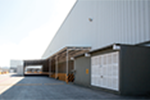 |
 |
 |
 |
 |
 |
 |
 |
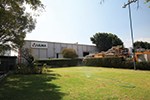 |
 |
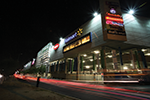 |
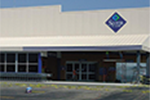 |
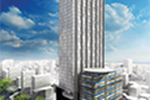 |
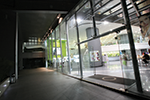 |
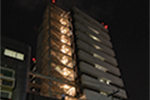 |
 |
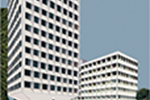 |
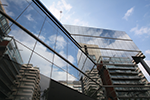 |
Inversionistas.
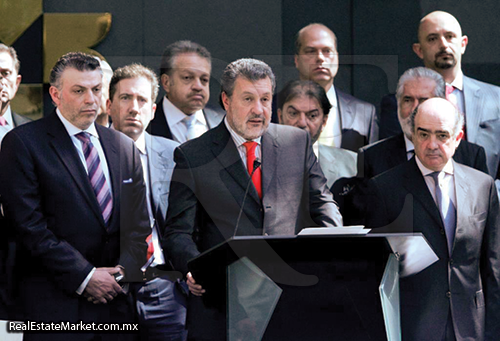
El Director Ejecutivo/ André El-Mann, El Presidente Ejecutivo de Grupo Financiero Santander México
Marco Martinez y el Presidente de la BMV, Luis Tellez, durante la ceremonia de la colocación de certificados Bursátiles de Fibra Uno./bmv
En su Oferta Pública Inicial (IPO) para la BMV Fibra Uno inició con 23 inversionistas institucionales de los cuales 23% eran extranjeros y el resto nacionales.
A la fecha cuenta con prácticamente todas las Afores mexicanas entre sus inversionistas, algunas aseguradoras y los fondos de pensiones para empleados de grandes empresas de México.
En estos casos, las inversiones se consideran de largo plazo y, por su estructura, las leyes fiscales les otorgan el beneficio de estar exentos del pago del Impuesto Sobre la Renta (ISR) por los dividendos que reciban de parte de Fibra Uno.
Su popularidad y atractivo han generado no sólo buenos rendimientos, sino gran demanda. Por ello el Fideicomiso fue incluido, desde junio de 2013, en los índices Morgan Stanley Capital International (MSCI).
Su participación en estos índices le brinda una exposición a nivel mundial, debido a que son utilizados por los grandes fondos de inversión como referencia para reflejar la evolución del valor de compañías que cotizan en las distintas bolsas del mundo.
| Inversionistas Institucionales de Fibra Uno* |
|---|
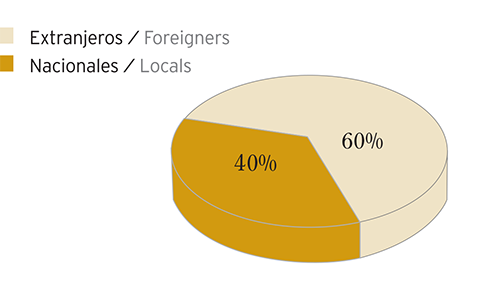 |
En tanto algunos inversionistas institucionales sólo se permiten invertir en empresas que coticen con dichos índices, Fibra Uno es marco de referencia para importantes carteras de inversión institucionales de todo el mundo.
Con esto logra generar mayor demanda de sus acciones y mantener un desempeño de liquidez favorable para todos sus accionistas. Respecto a sus inversionistas extranjeros, los montos de inversión que en el IPO alcanzaron un promedio de 20 mdd, fueron colocados en órdenes de hasta 100 mdd durante la última emisión adicional de Certificados Bursátiles Inmobiliarios (Follow-On). En este rubro destacan algunos fondos de inversión que administran los recursos de gobiernos de otros países, siendo el de Singapur uno de los mayores inversionistas de esta FIBRA.
Cabe señalar que en los ejemplos anteriores se hace alusión a posesiones institucionales que corren a largo plazo. En general, la posesión de sus CFBI es muy dinámica al ser de alta bursatilidad con un índice del 8.733 en mayo de 2013 y un volumen promedio de 12 millones de certificados diarios con cerca de 40 millones de dólares (mdd) valor promedio diario operado.
|
|
Aceptación en el mercado.
Fibra Uno se especializa en inversiones a nivel nacional para los sectores de oficinas, comercial e industrial en el sector inmobiliario y a la fecha cuenta con una excelente posición como vehículo de inversión
Ha mostrado un comportamiento sobresaliente en el mercado bursátil y cuenta con la capacidad de aprovechar nuevas oportunidades en esta industria conforme vayan surgiendo, en relación a la expansión de la economía mexicana y la demanda poblacional de más desarrollos inmobiliarios.
La regulación establecida para estos instrumentos de inversión, así como el potencial de su mercado local, son factores para que FUNO descarte la adquisición de activos en mercados extranjeros, que además añadirían complejidad a su portafolio en cuanto a la operación, regulaciones, procesos de negociación y esquemas tributarios.
Por otra parte, su estrategia de inversión y desarrollo incluye a los mercados desatendidos en México, con población creciente y niveles medios de ingreso para contribuir al crecimiento económico del país, generando un círculo virtuoso.
Las adquisiciones de Fibra Uno se caracterizan principalmente por su:
- “Prime location”: la ubicación debe de ser privilegiada en cualquier tipo de inmueble.
- Alta calidad de los inmuebles: materiales, acabados y proyecto arquitectónico, entre otros.
- Solidez financiera: las propiedades que adquieren deben tener arrendatarios con un sólido historial crediticio.
- Valor creciente de los activos: Cada propiedad adquirida añadirá más valor siempre.
Fibra Uno ha mostrado gran capacidad de negociación, experiencia en el mercado, posicionamiento y capacidad económica, lo que la convierten en una opción muy atractiva incluso para importantes participantes de la industria inmobiliaria. Muestra de ello es que, por lo menos en dos ocasiones, ha logrado adquirir portafolios con los que integra en su estructura a importantes jugadores del sector: Mexfund (portafolio azul) y GICSA (portafolio Morado).
De igual manera se ha caracterizado por su gran dimensión en cuanto a volúmenes de capital en algunas de sus transacciones. Por ejemplo, las operaciones realizadas para la adquisición de sus portafolios G30 y Morado están catalogadas dentro de las más grandes en la historia de los bienes raíces de México con valores que alcanzan los 18,400 y 11,600 millones de pesos (mdp), respectivamente.
Analizando estas operaciones, destaca que cualquiera de ellas pudo ser una FIBRA en sí misma, considerando que la base del “Market cap” de Fibra Uno en el IPO fue de 8,240 millones de pesos aproximadamente.
El posicionamiento con el que cuenta se ha convertido en una de sus ventajas competitivas frente al resto de las FIBRAS. La preferencia entre los propietarios de inmuebles para participar de manera conjunta en el fideicomiso de FUNO antes de ofrecerlos al resto, se debe a la rapidez y seriedad con la que pueden efectuar una transacción y concretar cualquiera de sus negocios.
Lo anterior, gracias a la liquidez con la que cuenta para realizar operaciones en el momento requerido y a las líneas de crédito de las que puede disponer.
Pero también por sus parámetros de inversión definidos para crear valor agregado a sus inversionistas, cuidando tanto sus intereses como la confianza brindada, y el análisis cuidadoso de las alternativas de inversión (valuaciones estrictas y metódicas).
| Inversionistas Institucionales de Fibra Uno* |
|---|
|
|
Estrategias
Bajo la ley mexicana, las FIBRAS están obligadas a distribuir por lo menos el 95% de su resultado fiscal anual a los tenedores de CBFI por lo menos una vez al año, sin embargo, Fibra Uno ha optado por una política de distribución trimestral.
Para lograr retornos atractivos con riesgo ajustado a largo plazo a sus acreedores, Fibra Uno analiza constantemente el mercado para identificar oportunidades de adquisición, desarrollo y alquiler de inmuebles con gran potencial de apreciación.
Adicionalmente ha establecido relaciones de negocio de largo plazo con sus principales inquilinos, entre los que se encuentran algunas de las más importantes empresas mexicanas y globales con presencia en México. Dicha relación consiste en sintonizar los planes de expansión de la FIBRA con las necesidades de desarrollo de los inquilinos cuyas estrategias coincidan con la visión de aprovechar el rápido crecimiento esperado en las ciudades de tamaño medio en México.
La estructura de integración vertical con la que trabaja en la adquisición y desarrollo, les permite minimizar costos frente a otros proveedores y reducir tiempos. Cuenta con un proceso interno de gestión integrado por administradores y operadores de inmuebles y distintos comités de análisis, evaluación y toma de decisiones para las inversiones. A continuación una descripción gráfica de su estructura y procesos:
| Plataforma de negocios de crecimiento continuo | |
|---|---|
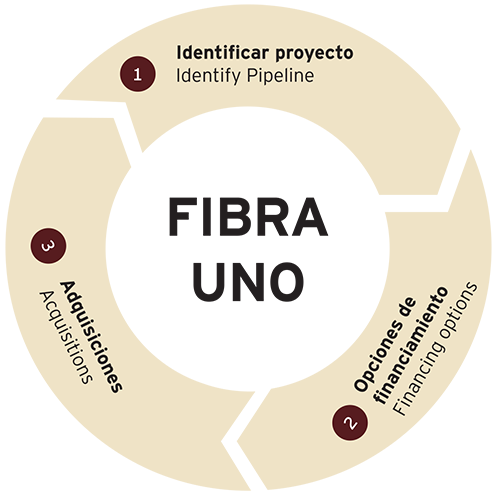 |
|
Diversificación del Portafolio FUNO
Cuenta con 314 propiedades en 29 estados de la República Mexicana, que suman un área rentable de aproximadamente 3,000,000 m2, de los cuales 284 propiedades están totalmente integradas. El resto pertenece al portafolio denominado G30 que a la fecha de esta publicación se encuentra prácticamente integrado.
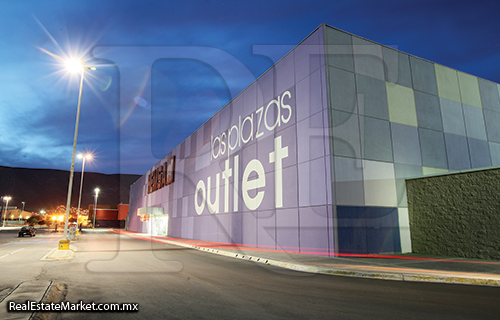
Tulti-Park. /Fibra Uno
Actualmente es la única FIBRA que participa en más de tres segmentos simultáneamente. Su portafolio de activos se integra principalmente por 40% de instalaciones industriales, 40% de centros comerciales y un 20% de oficinas.
También cuenta con inmuebles de usos mixtos, siete hoteles y terrenos para futuros desarrollos.
Cerca del 50% de sus propiedades se ubican en el Área Metropolitana del Valle de México, 20% en el sureste del país (Cancún, Mérida, Campeche y Chiapas), 15% en la zona occidente del país y el resto distribuido en otros estados.
| IPO (Marzo 2011) | Follow-on (Marzo 2012) | 1° trimestre (Marzo 31 2013) | Actual | |
|---|---|---|---|---|
| Propiedades | 16 | 40 | 281 | 312 |
| SBA* | 675,917 | 832,650 | 1,719,330 | 3,000,000 |
| Ocupación | 90.0% | 92.5% | 94.9% | 97.5% |
| Inquilino | 689 | 817 | 2,053 | 3,100 |
| Entidades | 7 estados | 15 estados | 29 estados | 29 estados |
| SBA por tipo de propiedad |
|---|
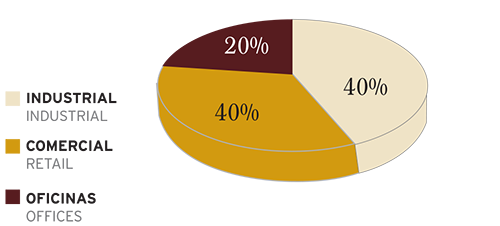 |
| Ocupación por giro |
|---|
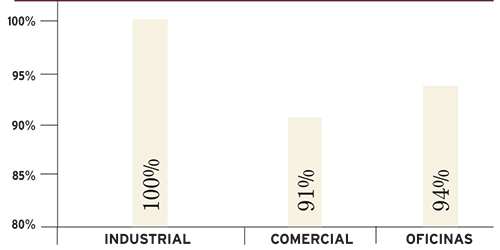 |
PRINCIPALES TRANSACCIONES
• Portafolio Azul (Mexfund)
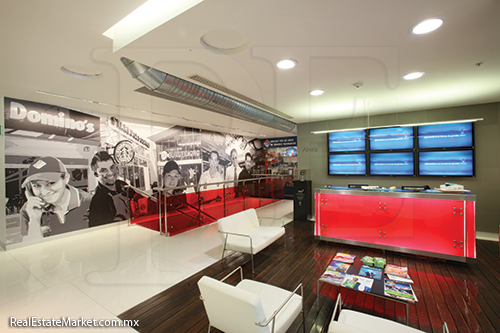
Reforma 222.
Operación:
- Precio de adquisición:1,032 millones de pesos
- Característica principal: 100% pagada en CBFI
- Importancia:Primera compra realizada donde adquirieron todo el equipo de management junto con los inmuebles para poder enfocar todo el crecimiento de la FIBRA
Inmuebles adquiridos
- Cantidad: 23
- Giro: Predominantemente comercial
- Dimensión: 126,466 m2 de área rentable
- Tasa de ocupación: 100%
- Inmuebles destacados:
- Universidad del Valle de México Zapopan
- Terraza Pedregal
- Oficina Reforma 222 (piso de 3,500 m2)
Ventaja Mexfund: Evitó la incertidumbre de incursionar de manera individual en la Bolsa al sumarse a un proceso que ha probado se exitoso y ser redituable con altos rendimientos a largo plazo.
• Portafolio Rojo (Santander)
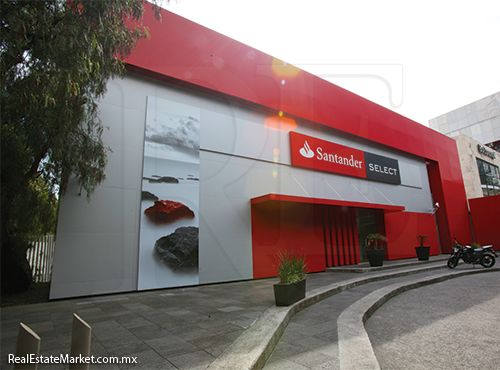
Santander Guadalajara.
Operación:
- Precio de adquisición:3,333 millones de pesos
- Característica principal: Esquema "Sale and Lease Back"
- Importancia: Con sólo un transacción se sumaron cerca de 200,000 m2 en distintos inmuebles, que cuentan con ubicaciones estratégicas al tratarse de oficinas y sucursales bancarias
Inmuebles adquiridos
- Cantidad: 219
- Giro: Corporativo
- Dimensión: 40 oficinas y 179 sucursales con un total de 173,884 m2 de área rentable
- Tasa de ocupación: 100%
- Inmuebles destacados:
- Corporativo Américas
- Centro de tecnología (Site) Periférico
- Sucursales: Reforma, Mazaryk y Palmas
Ventaja Mexfund: Adquirió liquidez por 3,333 millones de pesos y un contrato de arrendamiento por 20 años para no perder la ubicación de sus inmuebles, con beneficios como el operar bajo el régimen fiscal de leasing para sus instalaciones
• Portafolio Morado (GICSA)
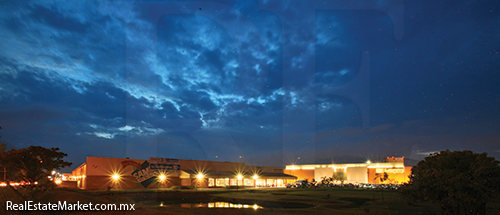
Fórum Tepic.
Operación:
- Precio de adquisición: 11,600 millones de pesos
- Característica principal: Pagado al 100% con CBFI
- Importancia: La segunda operación de capital más grande de la FIBRA entre un solo dueño y un comprador de una de las más grandes en la historia de los bienes raíces en México
Inmuebles adquiridos
- Cantidad: 16
- Giro: 8 inmuebles comerciales, 5 corporativos y 3 propiedades industriales
- Dimensión: 541,120 m2 área rentable
- Tasa de ocupación: 88%
- Inmuebles destacados:
- Centro Comercial La Isla Cancún
- Corporativo Punta Santa Fe
- Parque Industrial Tultitlán I y II
Ventaja Mexfund: En lugar de hacer su propia FIBRA, cambió gran parte de su portafolio por CBFI de FUNO, siendo más eficiente ya que se ahorró todos los gastos de colocación, road show, estructuración y operación

Edificio Anexo de Torre Mayor (Reforma 489).
Operación:
- Precio de adquisición: 389.510,021 dólares
- Característica principal: FUNO pagó con recursos propios el momento total de la transacción
- Importancia: Pasó a ser el principal socio Conjunto Torre Mayor
Inmuebles adquiridos
- Cantidad: 49% de derechor fiduciarios
- Giro:Principalmente corporativo
- Dimensión: 87,770 m2 área rentable
- Tasa de ocupación: 98%
Ventaja Mexfund: Reichmann International encontró un socio con quien pueda seguir desarrollando proyectos en México después de algunos años de inactividad. Actualmente ambos están construyendo el proyecto de Torre Diana, en conjunto con grupo MF
• Portafolio G30 (Gurpo-E)
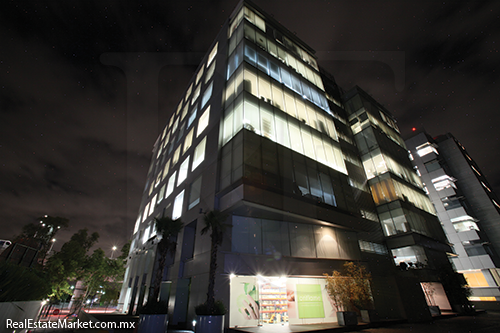
Torre Platino.
Operación:
- Precio de adquisición: 18,400 millones de pesos
- Característica principal: Se pagará con CBFI la absorción de la deuda pagando la inversión requerida para la construcción de los 9 proyectos que forman el Portafolio en desarrollo
- Importancia: El gran número de inmuebles industriales (13) que fueron adquiridos, rentados todos al 100% en la zona norte de la ciudad de México. Con esto la FIBRA equilibró su portafolio, además de adicionar más de un millón de metros cuadrados estabilizados y poco menos de otro millón para desarrollar
Inmuebles adquiridos
- Cantidad: 30
- Estabilizados: 21
- En desarrollo: 9
- Giro: Comercial, industrial y corporativo
- Dimensión:
- Estabilizados: 1,058,000 m2
- En desarrollo: 881,000 m2
- Ocupación promedio: 98% (estabilizado)
- Inmuebles destacados:
- En desarrollo:
- Corporativo Torre Latino, Reforma
- Industrial San Martín Obispo I y II
- Estabilizados:
- Corporativo Torre Platino
- Industrial Tlane-Park
- Industrial La Mexiquense
Nuevas Adquisiciones
Fibra Uno siempre está en busca de nuevos portafolios en el mercado. Su liquidez al cierre de esta edición es aproximada a los 18,500 millones de pesos, cantidad que busca utilizar para nuevas adquisiciones antes de finalizar el tercer trimestre del presente año.
Es importante tomar en cuenta que, preferentemente, el valor mínimo de una propiedad debe ser igual o superior a los 20 millones de dólares para ser adquirido por Fibra Uno.
Actualmente está considerando, varias propiedades industriales que en conjunto suman más de 1,000,000 m2 rentables con potencial a desarrollar hasta 314,000 m2 más, principalmente al norte del país.
Al cierre de esta edición se encontraba en trámites finales para adquirir 8 edificios de oficinas (Portafolio P8), el cual cuenta con 79,000 m2 de superficie, un nivel del 94% de ocupación y alrededor de 220 millones de pesos en ingresos.
Adicionalmente el pasado 15 de julio anunció la adquisición del Portafolio Apolo, compuesto por 49 propiedades comerciales, en su mayoría ancladas por tiendas de autoservicio. Esta transacción superó el monto de adquisición del portafolio G30, alcanzando un valor de 23,155 millones de pesos y convirtiéndose en la que quizá sea la transacción (en una sola exhibición) más grande del sector en la historia de México.
El 18 de junio de 2013 anunció la adquisición del Hotel Hilton, situado en el Centro Histórico de la Ciudad de México, por un valor de 1,163 mdp. Además, un centro comercial en desarrollo localizado en Aguascalientes con más de 15,000 m2 y ocho corporativos que en conjunto suman 78,982 m2 con una tasa de ocupación promedio del 94%. De éstos, uno se ubica en la zona de corporativos de la ciudad de Guadalajara y el resto en las avenidas de Reforma e Insurgentes de la Ciudad de México.
En Mayo del presente año Fibra Uno anunció su acuerdo con Reichmann International y Grupo MF para el desarrollo conjunto de Torre Diana, en la avenida Reforma, Distrito Federal. El Fideicomiso tiene una participación del 50% y
la otra mitad queda dividida entre los otros dos socios en tantos iguales. Con esto fortalece su posicionamiento en el rubro de oficinas ubicadas en uno de los corredores más importantes de México.
Siendo este su quinto inmueble en el corredor, con 33 pisos de oficinas A+, 63,000 m2 de área rentable, de los cuales 3,000 serán de uso comercial y el resto de oficinas. El proyecto tendrá una inversión de 165 millones de dólares, de los que Fibra Uno contribuirá con 50 millones. Una vez estabilizado (estimado para 2017) el Fideicomiso espera generar ingresos anuales por más de 17 millones de dólares.
Otras operaciones recientes incluyen la apertura del centro comercial Plaza Sendero Villahermosa en mayo de 2013, con 37,000 m2 de área rentable que albergan a tiendas como Soriana, Cinépolis y City Club, entre otras.
En el sector industrial, Lerma II, que se encuentra muy cerca del Aeropuerto Internacional de Toluca, cuenta con dos fases entregadas que suman 90,000 m2, la tercera está prácticamente terminada y la cuarta ha comenzado a construirse, los montos por arrendamiento también están por encima de su proyección original. Por su parte, la construcción de Vitro en Villahermosa está en tiempo y comenzará a recibir ingresos por rentas en el segundo trimestre de 2013.
Emisiones

Oferta Publica Inicial (IPO)/BMV
Fibra Uno también analiza constantemente las fuentes de financiamiento más adecuadas para respaldar su dinámica estrategia de crecimiento.
Tras su lanzamiento en la Bolsa, Fibra Uno empezó a despegar con paso firme y rapidez, al poder comprar y pagar inmuebles con sus propios Certificados Bursátiles y cumplir cabalmente con su compromiso de distribuir los dividendos de sus acciones cada trimestre del año.
A tan solo un año de su Oferta Pública Incial, FUNO concretó la adquisición de Mexfund, primer portafolio importante de un paquete grande de inmuebles, mostrándole al mercado que Fibra Uno podía empezar a ser un gran consolidador de inmuebles en arrendamiento, porque podía adquirir importantes portafolios capaces de generar mayor valor.
Con esa operación se ancló el primer aumento de capital para marzo de 2012, regresando al mercado con una oferta pública de 700 millones de dólares. Con esto se duplicaba el tamaño de la base de inversionistas internacionales y el valor promedio del ticket de éstos.
Para esta primera emisión adicional de CBFI o Follow-on, hubo 45% de inversionistas extranjeros y el resto fueron nacionales. También se sumaron 6 afores a las cuatro de la Oferta Inicial, llegando a 10 de las 12 administradoras que hay en el mercado mexicano.
Este acontecimiento vuelve a proporcionar certidumbre sobre el instrumento de Fibra Uno, pues siendo pionera en este mercado, no se tenía un parámetro claro sobre las expectativas reales de poder lograr un primer Follow-On.
Para enero de 2013, es decir, a menos de un año del primero, hubo 133 inversionistas institucionales de los cuales el 60% eran extranjeros y el resto nacionales.
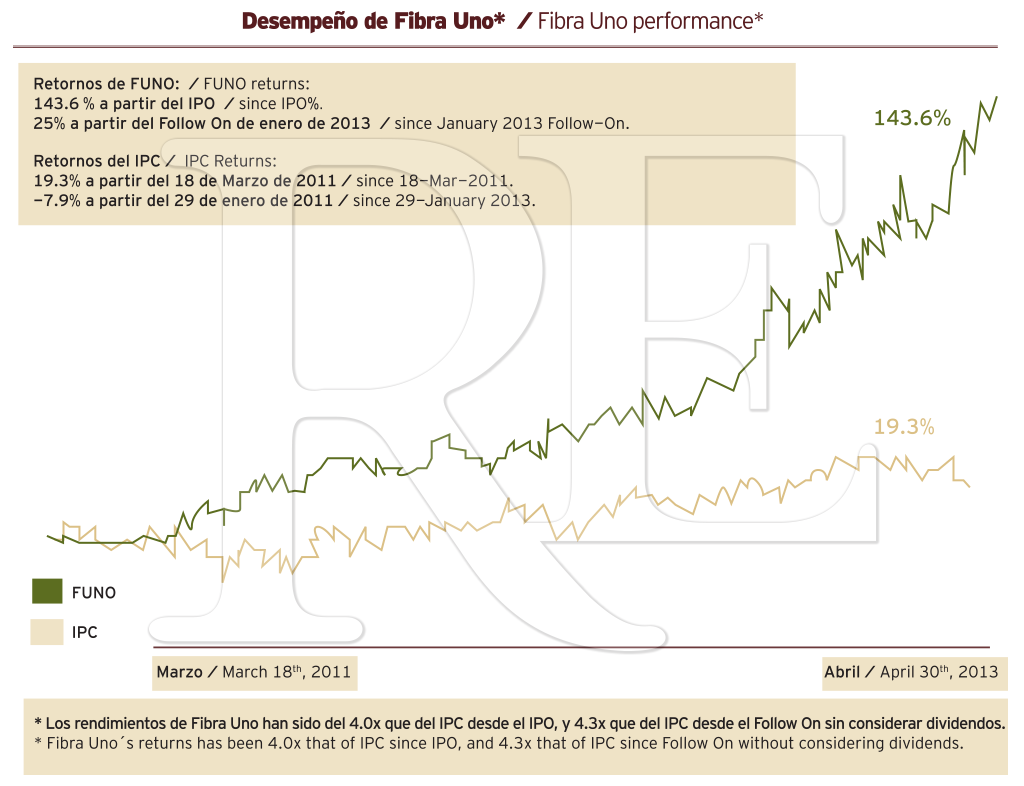
Gerald Ricker
Director General de Reichmann International en México.
REM- En el marco del décimo aniversario de la construcción de Torre Mayor, ¿qué nos puede decir sobre la reciente adquisición del 49% de los derechos fiduciarios por parte de Fibra Uno?

Lic. Gerald Ricker,
Director General de Reichmann International en México/AGV
GR- Aunque el hecho de que el 10° Aniversario de Torre Mayor y la adquisición del 49% por parte de Fibra Uno fueran una coincidencia, puedo decir que en Reichmann International estamos muy orgullosos de contar con Fibra Uno como socio de Torre Mayor. Fibra Uno es un grupo de inversión inmobiliaria que cuenta con gente muy sagaz y profesional, la cual posee una cartera de activos de muy alta calidad. Esperamos tener una larga y beneficiosa relación con ellos.
REM- ¿Qué se espera del mercado de las oficinas en México con la participación de Fibra Uno en la industria de los Bienes Raíces?
GR- En general, esperamos que el Mercado de Oficinas de Clase “A” en la Ciudad de México se duplique en los próximos 10 años con el fin de satisfacer las necesidades de crecimiento del sector de servicios de la economía de México. La capacidad de Fibra Uno para identificar e importar capital extranjero y reunir inversionistas nacionales será de vital importancia en este crecimiento.
REM- ¿Cuáles considera que han sido las aportaciones de Fibra Uno a la confianza que Reichmann tiene en México?
GR- Evidentemente la confianza de Reichmann en México se ha acentuado enormemente, como la de cualquier inversionista extranjero debería por los importantes compromisos del calibre y calidad de los inversionistas institucionales que forman parte de los accionistas de Fibra Uno. Reichmann está tan optimista por los próximos 20 años de México como cuando adquirimos el terreno para Torre Mayor hace unos 20 años.
REM- ¿Por qué impulsar nuevos proyectos de la mano de esta FIBRA, como el de Torre Diana, después de 10 años de no construir en nuestro país?
GR- En realidad, Reichmann adquirió el terreno para Torre Diana hace 6 años. Hemos estado trabajando diligentemente para lograr la re-zonificación, la concesión de permisos, y el diseño para el proyecto de Torre Diana durante todo este tiempo. El mercado es idóneo ahora para el desarrollo y arrendamiento de Torre Diana. Reichmann piensa que la sociedad que hemos logrado, la cual incluye Fibra Uno y el Grupo Farca, es el equipo adecuado para seguir adelante. Los proyectos de Reichmann, por su propia naturaleza, son de una escala tan grande que debemos igualar su ritmo con las necesidades de los clientes a quienes servimos. El momento de Torre Diana es ahora.
REM- ¿En su opinión, hacia dónde va Fibra Uno?
GR- Evidentemente, nosotros sólo somos socios y por lo tanto no tenemos ningún conocimiento especial o privilegiado sobre las estrategias o planes de Fibra Uno. Sin embargo, Reichmann ha patrocinado varios REIT’s (fondos de inversiones inmobiliarias) propios en Canadá, así que no nos sorprendería si Fibra Uno sigue creciendo tanto por las adquisiciones estratégicas, así como por la diversificación en las adquisiciones de diferentes clases de activos inmobiliarios. Además, con base en la experiencia de Reichmann con su propios REIT’s en los EE.UU. y Canadá, tampoco me sorprendería si Fibra Uno estudia los diferentes elementos que intervinieron en las adquisiciones anteriores en los últimos 2 años, tal vez con el fin de refinanciarlos y así aprovechar las históricamente bajas tazas de interés ahora disponibles en el mercado.
En cualquier caso, para una empresa del tamaño y la calidad de Fibra Uno que está tan bien posicionada, sabrá aprovechar las oportunidades al mismo tiempo que la economía de México se expande en la próxima década y más allá.
REM- ¿Qué espera Reichmann International de su asociación con Fibra Uno para desarrollar proyectos en conjunto?
GR- Fibra Uno da acceso al capital para el cual México está siempre en demanda. Reichmann ha demostrado claramente su experiencia en el desarrollo, comercialización y gestión a gran escala, de proyectos de oficina Clase “A” de gran envergadura y, por lo tanto, al hacer equipo con Fibra Uno, que ha demostrado su capacidad para importar capital de inversión directa del extranjero, parece haber sido una excelente combinación. Esperamos con interés el desarrollo de nuevos proyectos junto con Fibra Uno en el futuro.
REM- ¿Tiene planeado otros proyectos a futuro en México?
GR- Reichmann International siempre se ha comprometido en aportar un valor agregado al Distrito Central de Negocios de las principales ciudades del mundo en las que participa. Algunos ejemplos son: el First Canadian Place en Toronto, el World Financial Center en Nueva York, y, por supuesto, el famoso Canary Wharf en Londres. En la Ciudad de México esto significa, el Corredor Reforma y esperamos seguir contribuyendo al crecimiento de este vital segmento de mercado de oficinas Clase “A” en la Ciudad de México en el futuro.
REM- Comentarios que desee agregar.
GR- Torre Mayor acaba de celebrar su 10 º Aniversario y sigue siendo el edificio de oficinas más eficiente y productivo en México. Torre Mayor también logró recientemente la Certificación LEED GOLD bajo en su categoría EBOM por parte del United States Green Building Council (certificación para edificios existentes), el primer premio como tal en todo México. Esperamos que Torre Diana siga los pasos de Torre Mayor. Estamos muy orgullosos que Reichmann International cuente con Fibra Uno como socio en ambos proyectos. Esperamos una larga relación que sea gratificante para ambas partes.
Gonzalo Robina
Director General Adjunto de Fibra Uno
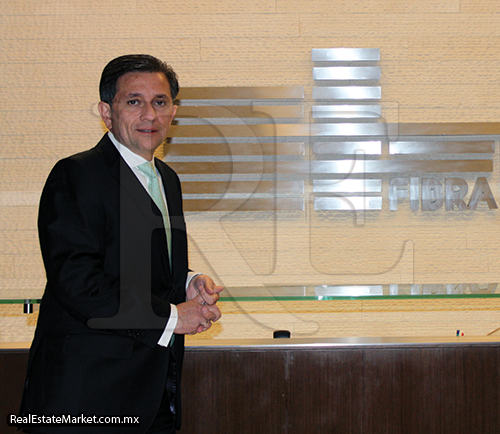
Gonzalo Robina
Director General Adjunto de Fibra Uno
REM- ¿Cómo surge Fibra Uno?
La realidad es que el tema de la inversión en bienes raíces ha estado presente históricamente, siempre la gente ha tratado de refugiar sus ahorros en el mercado inmobiliario. En 1963 surge la figura de los REITS en Estados Unidos y tienen un boom muy importante durante los noventa y realmente después de ese boom en Estados Unidos es cuando empieza a tener ese auge en los mercados emergentes.
Prácticamente a partir del año 2000 se comenzó a masajear el tema en México y fue hasta hace un par de años que este vehículo nace en el mercado a través del lanzamiento de la primera Fibra en México, que somos nosotros.
El génesis de nuestro fideicomiso es el portafolio de inmuebles de nuestros socios fundadores, del grupo de control, quienes tuvieron la visión de revolucionar esta industria y trabajaron durante muchos años en que nuestro mercado tuviese las alternativas de inversión y desarrollo que se encuentran disponibles en otros países y que han probado ser muy exitosas. La verdad es que fue una labor que se llevó muchos años para poder lograrlo a fin de cuentas en marzo de 2011.
REM- ¿Por qué convertirse en una FIBRA?
El iniciar como empresa pública fue una decisión que nos llevó bastantes años tomar, principalmente porque no existía una regulación que fomentara y apoyara el desarrollo de este tipo de fideicomisos.
De esta forma en conjunto con autoridades y de la mano del despacho del Dr. Pedro Azpe fuimos madurando el diseño y estructura y los incentivos adecuados para salir al mercado. Hoy a poco más de dos años de distancia de nuestra Oferta Pública Inicial vemos que tomamos la decisión correcta y nos sentimos orgullosos del éxito alcanzado, de haber sido los pioneros y de poder compartir esto con nuestros tenedores.
REM- Si un desarrollador cumple con las condiciones para bursatilizarse:
¿Por qué optar en incorporarse a Fibra UNO?
A fin de cuentas lo que ha pasado es que a muchos de estos grupos de desarrolladores que tenían grandes portafolios, la sinergia de subirse a un grupo con el peso específico que tenemos o que desde entonces teníamos ya dentro de la FIBRA, la verdad es que les hacía mucho sentido.
De hecho tenemos el caso de Gicsa y G30, que son portafolios que por su tamaño, en el momento en que nosotros los adquirimos eran más grandes que el monto de la Oferta Pública que hicimos nosotros inicialmente, pero por los costos de explorar la colocación, que la verdad es que son muy caros y los precios que nosotros les podíamos pagar dado el premio que ya nos estaba dando el mercado en su momento, no tenía sentido para ellos el explorar de manera individual esa colocación, sino que, al sumarse con nosotros tomaron como moneda de pago los Certificados y todos están encantados con los resultados que han obtenido a través de esto.
REM- ¿Diría usted entonces que se evita el riesgo y los costos de operación para obtener beneficios inmediatos?
¡Así es!, cuando tú haces una colocación normalmente tienes que darle un descuento al mercado por liquidez, para que te conozcan, etc. y aquí es al revés, en el momento en que cerramos la operación y lo anunciamos, es inmediata la reacción del mercado y suben el precio de los Certificados.
Si vemos históricamente el comportamiento del precio de los certificados, cada vez que se anuncia alguna compra importante como fue el caso de estos portafolios o el de la Torre Mayor, la reacción del mercado es instantánea y suben el precio de los certificados. Entonces el desarrollador que está aportando el portafolio, del día que recibe sus certificados al siguiente, empieza a obtener plusvalía.
REM- Fibra Uno, ¿es para cualquier inversionista?
Realmente sí es. Si estamos hablando de inversionistas que compran certificados en el mercado abierto, depende de las políticas de las casas de bolsa, pero puedes comprar certificados de Fibra Uno desde 4,000 pesos.
A parte otra de las ventajas es la flexibilidad. porque si bien pueden ser 4,000 10,000 o 15,000 pesos, en ocasiones no te puedes salir o tienes que dejar congelado durante algún tiempo ese dinero y la verdad es que la bursatilidad que estamos teniendo te permite entrar y salir a diario sin ningún problema. Entonces tú puedes tener unos ahorros, meterlos ahí y si tienes cualquier imprevisto o lo que sea, puedes disponer de ellos en 24 horas.
REM- ¿Cómo elige esta Fibra sus portafolios?
Mira, nosotros construimos selectivamente una cartera diversificada de propiedades destinadas al arrendamiento de alta calidad. Yo considero que la característica principal es la calidad de nuestros arrendamientos, con excelentes ubicaciones y generadores de altos ingresos.
Buscamos adquirir propiedades ubicadas en sitios principales, en mercados urbanos con altos niveles de consumo y alta actividad económica, tal es el caso de nuestros concentrados en el Distrito Federal, Toluca, Guadalajara y Cancún. También nos enfocamos en áreas metropolitanas de mediano tamaño que presentan un alto crecimiento demográfico y donde tengamos oportunidades de ofrecer servicios de entretenimiento y opciones comerciales para áreas desatendidas.
REM- ¿Para qué diversificarse y hasta dónde hacerlo?
Yo considero que hoy el mercado nos ha premiado la diversificación. No descartamos que a mediano plazo tengamos que hacer un destino de la FIBRA y terminemos teniendo una Fibra Uno Industrial, Fibra Uno Comercial, Fibra Uno de Oficinas, etc. En su momento lo vamos a hacer, seguramente cuando detectemos que el mercado lo puede valorar de mejor manera que teniendo la diversificación con la que contamos actualmente.
Hoy si tú te metes a ver, por ejemplo la FIBRA hotelera en México, pues obviamente su REIT está concentrado en un solo sector. Lo que pasó en Estados Unidos cuando surgieron en 1963 las FIBRAS, es que eran también diversificadas y conforme se fue sofisticando el mercado se fueron especializando, entonces estamos abiertos y preparados para hacerlo en el momento en que el mercado nos lo dicte.
REM- ¿Han pensado en abrirse a otros sectores del mercado inmobiliario?
Básicamente no se excluye ningún sector per-se, lo que realmente buscamos y el objetivo principal de las FIBRAS son los inmuebles que tengan un flujo de arrendamiento, puede ser un hospital, escuela, hotel, un edificio de oficinas. Al final de cuentas el objetivo final de la FIBRA es la generación de un flujo a través del arrendamiento.
Prácticamente nos hemos concentrado en el sector industrial, comercial, de oficinas y un poco los hoteles porque es donde hemos tenido mayor experiencia, más radio de acción y donde se han presentado todavía muchas oportunidades que queremos consolidar.
Tal vez cuando se empiecen a secar estas oportunidades dentro de estos tres ramos, tendremos que empezar a explorar y crear nuevos. Acuérdate que hemos sido pioneros en esto, prácticamente la totalidad de los inmuebles que hemos adquirido de los portafolios con los que contamos, no eran producto que estuviera disponible en el mercado, nuestra labor fue prácticamente ir a generar las alternativas. Entonces en su momento las buscaremos, cuando se nos hayan secado el resto de estos sectores.
REM- Las Fibras como un instrumento para generar nuevos desarrollos ¿hasta dónde es posible?
Lo vemos posible por medio de dos vías, la primera es que contamos con los recursos, la experiencia y los procesos adecuados para emprender los desarrollos que nuestro país demanda y lo hacemos de una forma bastante rápida y eficiente con una estructura de costos que maximiza los retornos sobre la inversión. Aquí los volúmenes que nosotros manejamos en los desarrollos es muy grande, hoy tenemos básicamente bajo construcción cerca de un millón de metros cuadrados. Entonces esos volúmenes en los consumos de materias primas y de proveedores nos dan mucho apalancamiento ahí.
La segunda es que con la adquisición de grandes portafolios (Mexfund, GICSA, MRP, entre otros) Fibra Uno ha aportado a que estos mismos desarrolladores tengan la capacidad de volver al mercado inmobiliario con nuevos desarrollos.
En resumen, se vuelve un ciclo virtuoso: ellos desarrollan, aportan al Fideicomiso y con los recursos que les regresa la Fibra hacen nuevos desarrollos, aportan de nuevo y se vuelve un círculo. Yo te puedo decir que casi es una regla que se ha dado, que todos los que han contribuido o nos han vendido los inmuebles, con estos recursos regresan dentro de la misma industria inmobiliaria a desarrollar directa o indirectamente más inmuebles.
REM- ¿Qué beneficios otorga y recibe de otros instrumentos como las AFORES?
Por el perfil de inversión que representamos somos un candidato natural para la cartera de inversionistas institucionales y fondos de pensiones, contribuimos realmente a diversificar su inversión y por consiguiente a disminuir su riesgo.
Para Fibra Uno es importante contar con este tipo de inversionistas porque la mayoría de ellos tiene un horizonte de inversión a largo plazo, lo que genera una demanda importante para nuestros Certificados y contribuye a la estabilidad y futura apreciación de su valor.
REM- ¿Apuntalarán la creación de un Índice de FIBRAS en la Bolsa?
Hemos estado en contacto con las autoridades de la Bolsa Mexicana de Valores y definitivamente nosotros estaremos apuntalando la creación del Índice de FIBRAS, pero realmente la voluntad de Fibra Uno o nuestra predilección es que se incluyan a las FIBRAS dentro del Índice de Precios y Cotizaciones de la BMV, porque a fin de cuentas hoy existimos cinco FIBRAS y se que vienen muchas más en el camino, pero preferiríamos formar parte de este Índice que te comento para que se nos mida como una empresa de capital y que nos midamos con muchas otras más en el mercado de capitales.
REM- ¿Hacia dónde va Fibra Uno? ¿Hacia dónde la figura legal de las FIBRAS?
Nuestro futuro está ligado al crecimiento y desarrollo del país y el sector. Nuestra visión de crecimiento es alentadora porque vemos un mercado con mucho potencial y porque las condiciones de nuestro país, comparado con el entorno internacional, son inmejorables. Yo considero que nunca habíamos estado en una condición como esta.
Nuestra curva de experiencia en la industria y lo que hemos demostrado son una plataforma ideal para continuar creciendo. Desde el punto de vista legal te diría que consideramos que existe trabajo por hacer por parte de todos lo que participamos en el mercado autoridades, reguladores, legisladores, intermediarios, porque estamos convencidos de que todo es mejorable. Como todos los mercados en constante evolución debemos trabajar y ser innovadores para beneficiar a toda nuestra cadena de valor.
Texto Christopher Montiel & Real Estate
Fotos: BMV, FIBRA UNO, REICHMAN INTERNATIONAL, AGV
English
Fibra Uno
Investment attraction for distinguished portfolios
It counts with nearly 3,000,000 square meters in leasing space and more than five billion dollars of capitalization value
It is the first and foremost Mexican REIT or FIBRA (as known in Mexico) listed in the Mexican Stock Market since 2011
Emergence
The sponsor group of Fibra Uno has dedicated a length of four decades to the acquisition, development, leasing and operation of industrial assets, commercial, touristic, offices and mixed use developments in Mexico.That experience was a key factor in the composition and launching of the first Mexican REIT, Fibra Uno or FUNO, as known for its ticker symbol in the Mexican Stock Market.
The beginning of its real estate activities dates back to the 70´s, when its majority share holders focused on the real estate business based on the need to acquire well-located properties, which would adhere to its quality standards and offer a reasonable lease to spearhead its paint franchise.

In the 1980’s they began to acquire and develop lands, taking advantage of the need to built additional commercial spaces to be leased to other businesses. Once the opportunity presented itself in that sector, it produced a change in the entrepreneurial vision, focusing in on the real estate business and widening the property portfolio.
In the early 90’s, they built their first industrial installation and began expanding in other sectors like tourism, offices and mixed use developments in the real estate industry of the country.
Making the most of the experience gained during this trajectory, in 2010 the FUNO structure was shaped. The 18th of March, 2011 it launched an IPO in the Mexican Stock Market under the FIBRA regimen (which is based on the Real Estate Investment Fund or REIT); the first of its kind in Mexico.

Fibra Uno´s Management Team / Gonzalo Robina, Gerardo Del Ángel, Javier Elizalde
Eleazar Pulido, Ignacio Tortorielo, Jesús Estrada.
This offer was launched with the acquisition of 16 properties in the portfolio, all leased and without debt. Of these, 14 were given meaning a contribution to the Trust Fund in exchange of securities or CBFIs (Certificados Bursátiles Fiduciarios Inmobiliarios in spanish) and the other two were acquired by generated capital through the public offer.
Its structure is based on a diversified portfolio of strategically placed properties destined toward leasing. It covers a vast array of real estate sectors in Mexico like: industrial, commercial, touristic, offices and mixed use developments with the exception of the residential. Throughout the leases, income is generated for the investors that have acquired their CFBIs, making this a very attractive tool for any investor.
| • Portafolio azul (MEXFUND) Noviembre de 2011 | ||||||||||||||||||||||||
|---|---|---|---|---|---|---|---|---|---|---|---|---|---|---|---|---|---|---|---|---|---|---|---|---|
| Property: Hermosillo Type: Industrial State: Sonora |
Property: UVM Zapopan Type: Comercial State: Jalisco |
Property: Reforma 222 Type: Oficinas State: Distrito Federal |
Property: Terraza Pedregal Type: Comercial State: Distrito Federal |
Property: Aguascalientes Type: Comercial State: Aguascalientes |
Property: Acapulco Type: Comercial State: Guerrero |
Property: Olivar de los Padres Type: Comercial State: Distrito Federal |
Property: Alameda Type: Comercial State: Distrito Federal |
Property: Naucalpan I Type: Comercial State: Estado de México |
Property: Tijuana Type: Comercial State: Baja California |
Property: Mexicali Type: Comercial State: Baja California |
Property: Miguel Ángel de Quevedo Type: Comercial State:Distrito Federal |
Property: Santa Fé Type: Comercial State: Distrito Federal |
Property: Arboledas Type:Comercial Satet: Estado de México |
Property: Monterrey Type: Comercial State: Nuevo León |
Property: Cofre de Perote Type: Comercial State: Distrito Federal |
Property: Edison Insurgentes Type: Comercial State:Distrito Federal |
Property: Del Valle Type: Comercial State: Distrito Federal |
Property: Yucatán 23 Type: Oficinas State: Distrito Federal |
Property: Tlahuac Type: Oficinas State: Distrito Federal |
Property: Leones Type: Oficinas State: Distrito Federal |
||||
|
|
 |
 |
 |
 |
 |
 |
 |
 |
 |
 |
 |
 |
 |
 |
 |
 |
 |
 |
 |
 |
||||
| • Portafolio rojo (SANTANDER) Abril de 2012cc | ||||||||||||||||||||||||
|---|---|---|---|---|---|---|---|---|---|---|---|---|---|---|---|---|---|---|---|---|---|---|---|---|
| Property: Reforma Type: Comercial State: Distrito Federal |
Property: Américas Type:Oficinas State: Guadalajara |
Property: Santa Fé Type: Oficinas State: Distrito Federal |
Property: Site Periférico Sur Type:Oficinas State:Distrito Federal |
Property: Periférico Type: Oficinas State: Distrito Federal |
Property: mérida Type: Comercial State: Yucatán |
Property: Av. Reforma Type: Comercial State: Distrito Federal |
Property: Monte Elbruz Type: Comercial State: Distrito Federal |
Property: Mazarik Type: Comercial State: Distrito Federal |
Property: insurgentes Sur Type: Comercial State: Distrito Federal |
Property: Ruiz Cortines Type: Comercial State:Distrito Federal |
Property: Bosques del Valle Type: Comercial State: Nuevo León |
Property: Jose Vasconcelos Type: Comercial State: Nuevo León |
Property: C. Doblado Type: Comercial State: Nuevo León |
Property: Blvd. Interlomas Type: Comercial State: Estado de México |
Property: Lomas Verdes Type: Comercial State: Estado de México |
Property: Palmas Type:Comercial State: Distrito Federal |
Property: Benito Juárez Type: Comercial State: Sonora |
|||||||
 |
 |
 |
 |
 |
 |
 |
 |
 |
 |
 |
 |
 |
 |
 |
 |
 |
 |
|||||||
| • Portafolio morado (GICSA) Agosto de 2012 | ||||||||||||||||||||||||
|---|---|---|---|---|---|---|---|---|---|---|---|---|---|---|---|---|---|---|---|---|---|---|---|---|
| Property: Tultitlán I Type: Industrial State:Estado de México |
Property: Tultitlán II Type: Industrial State: Estado de México |
Property: Tlanepantla Type: Industrial State: Estado de México |
Property:Outlet Type:Comercial State:Guadalajara |
Property: Outlet Monterrey Type:Comercial State:Nuevo León |
Property: Forum Tepic Type:Comercial State: Nayarit |
Property: La isla Type:Comercial State:Quintana Roo |
Property: Forum by the Sea Type:Comercial State:Quintana Roo |
Property: Punta Langosta Type:Comercial State:Quintana Roo |
Property: Centro Maya Type:Comercial State:Quintana Roo |
Property: Outlet Cancún Type:Comercial State:Quintana Roo |
Property: Punta Santa Fe Type:Oficinas State:Distrito Federal |
Property: Corporativo Insurgentes Type:Oficinas State:Distrito Federal |
Property: Corporativo Interlomas Type:Oficinas State:Estado de México |
Property: Edificio Monterrey Type:Oficinas State:Nuevo León |
Property: Corporativo Polanco Type:Oficinas State:Distrito Federal |
|||||||||
 |
 |
 |
 |
 |
 |
 |
 |
 |
 |
 |
 |
 |
 |
 |
 |
|||||||||
| Portafolio G30 Diciembre de 2012 | ||||||||||||||||||||||||
|---|---|---|---|---|---|---|---|---|---|---|---|---|---|---|---|---|---|---|---|---|---|---|---|---|
| Property: San Martín Obispo I Type:Industrial State:Estado de México |
Property: San Martín Obispo II Type:Industrial State:Estado de México |
Property: Tlane-Park Type:Industrial State:Estado de México |
Property: Tlane-Park II Type:Industrial State:Estado de México |
Property: Tulti-Park Type:Industrial State:Estado de México |
Property: Iztapalapa Type:Industrial State:Distrito Federal |
Property: La Joya III Type:Industrial State:Estado de México |
Property: La Joya IV Type: Industrial State:Estado de México |
Property: James Watt Type:Industrial State: Estado de México |
Property: Puente Grande Type:Industrial State:Estado de México |
Property: Maravillas II Type:Industrial State:Estado de México |
Property: La Mexiquense Type: Industrial State: Estado de México |
Property: Las Américas Type: Industrial State: Qintana Roo |
Property: La Purísima Type: Industrial State: Estado de México |
Property: Ceylan Type: Industrial State: Estado de México |
Property: Gustavo Baz Type:Industrial State:Estado de México |
Property: Tecno Parque Berol Type:Industria State: Estado de México |
Property: Centro Lago de Guadalupe Type:Comercial State:Estado de México |
Property: Pabellón Salinas Cruz Type: Comercial State: Oaxaca |
Property: Torre Latino Type:Oficinas State:Distrito Federal |
Propiedad: Torre Platino Tipo:Oficinas Entidad:Distrito Federal |
Property: Torres Adalid Type:Oficinas State:Distrito Federal |
Property: Tlacotalpan Type: Oficinas State:Distrito Federal |
Property: Mariano Escobedo Type: Oficinas State:Distrito Federal |
Property: Torre CP-6 Plaza Type: Oficinas State: Distrito Federal |
 |
 |
 |
 |
 |
 |
 |
 |
 |
 |
 |
 |
 |
 |
 |
 |
 |
 |
 |
 |
 |
 |
 |
 |
 |
Investors

The CEO / André El-Mann, / The president of Grupo Financiero Santander México
Marco Martinez and the President of the Mexican Stock Market , Luis Tellez, during Fibra Uno´s share issue ceremoney
In its Initial Public Offer (IPO) for the Mexican Stock Market Fibra Uno began with 23 institutional investors, of which 23% of which were foreign and the rest Mexican.
Up to date with practically all the Mexican Afores, among its investors, some insurance companies and the pension funds for employees of great national enterprises.
In these cases, investments are considered as long-term, and due to its structure, the fiscal laws grant the benefits of being exempt from the Income Tax payment (ISR in Mexico) of the dividends received on behalf of Fibra Uno.
Its popularity and appeal have generated not only good performance, but huge demands. Because of this, the Trust Fund was included as of June 2013 in the Morgan Stanley Capital International Index (MSCI).
The participation and impact of these indicators has rendered worldwide exposure, due to the use of the most important investment funds as a reference to reflect the value evolution of companies listed in the Stock Markets around the world.
Whereas a number of these institutions only allow investment in enterprises listed in these indexes, Fibra Uno is a benchmark for important institutional investment portfolios worldwide.
| Fibra Uno´s institutional investors* |
|---|
 |
Thus attaining greater demand for its shares and keeping up a positive liquidity performance for all the share holders.
In relation to its foreign investors, the average investment amount, that during the IPO was valued at 20 million dollars, reached up to 100 million dollars during the last additional emission or Follow-On. Some investment funds managing government resources from other countries stand out, such as Singapore, a major investor in this FIBRA.
It should be noted to point out that in the previous examples the allusion is made to institutional possessions running on the long-term. In general, the possession of its CFBIs is very dynamic due to their high trade volume. On May 2013 this reached an index of 8.733 and an Average Daily Trading Volume (ADTV) of 12 million certificates with over 40 million dollars average daily value.
|
|
Market acceptance
Fibra Uno specializes in national level investments for offices, commercial and industrial sectors. In the Real Estate field, up to date it counts with an excellent position as an investment vehicle.
It has demonstrated an outstanding behavior in the Stock Market and has proven the ability to take advantage of new opportunities in the industry as these come out, following the Mexican economy and the population demand of more real estate developments.
The regulation for these investment instruments as well as the local market potential, are factors to discard foreign acquisitions for FUNO. Besides that these would add complexity to the operation, regulations, negotiation processes and tributary outlines of its portfolio.
On the other hand, its investment strategy and development includes the disadvantaged markets in Mexico with increasing population and medium levels of income, participating this way in the economic growth of the country, generating a virtuous circle.
The acquisitions of Fibra Uno are mainly characterized by:
- Prime Location: the location must be privileged in any type of asset
- High quality properties: materials, finishes and architectonic project, among others
- Financial strength: the acquired properties must have tenants with a solid credit history
- Accretive acquisitions of assets: Each property will always add more value
Fibra Uno has demonstrated excellent negotiation capacities, experience in the market, positioning and economic capacity, which makes it a very attractive option, even for other important participants of the real estate industry. As evidence, at least on two occasions it has managed to integrate important real estate companies to its portfolio: Mexfund (Azul Portfolio) and GICSA (Morado portfolio).
Likewise it has characterized by its great dimension as far as capital volumes for some transactions. For example, the operations made for the acquisition of its G30 and Morado portfolios are catalogued amongst the largest in Mexico’s real estate history with values that reach the 18,400 and 11,600 million pesos respectively.
Analyzing these operations, it stands out that each of them could have been a FIBRA by its own, considering that the Market Cap base for Fibra Uno´s IPO was 8,240 million pesos approximately.
The market positioning that holds has turned into one of its competitive advantages as compared with the rest of the FIBRAs. The preference among the properties owners for participate jointly with the trust fund of FUNO before offering it to others is due to the swiftness and seriousness with which they can make a transaction and set any of their businesses.
The previously mentioned, thanks to the liquidity with which is count to make operations in the required moment and to the credit lines of which it can dispose.
But also for its defined investment parameters in order to create added value to its investors, taking care of both, their interests and given trust, and the careful analysis of the investment choices (strict and methodical valuations).
| Firtst Fibra cycle completed Second FIBRA cycle to be completed |
|---|
|
|
Strategies
Under the Mexican law, these REITS must distribute at least 95% of the fiscal annual results to the holders of the CBFIs at least once a year. However Fibra Uno has chosen for a quarterly distribution policy.
To achieve attractive returns with the adjusted risk at long-term with its creditors, Fibra Uno constantly analyses the market to identify opportunities of acquisition, development and rent of the real estate with great potential of appreciation.
Additionally has established long-term business with its major tenants, among which are some of the most important Mexican and global companies with operations in Mexico. This relationship is to synchronize the Mexican REIT expansion plans with the development needs of tenants whose strategies match the vision to harness the rapid growth expected in medium-sized cities in Mexico.
The vertical integration structure chosen to work with, on the assets acquisition and development, allows it to reduce times and minimize costs in compare with other providers. It counts with an internal gestation process integrated with administrators and assets operators, as well as several analysis committees, evaluation, and decision making for the investments. Coming up next, we will show a graphic description of its structure and processes:
| Continuing growth business platform | |
|---|---|
 |
|
FUNO´s Portafolio diversification
It counts with 314 properties distributed on 29 States of the Mexican Republic, of which 284 are completely integrated, adding a rentable area of nearly 3,000,000 square meters. The remaining belongs to the portfolio known as G30 that at the end of this publication is essentially integrated.

Tulti-Park. /
Currently it is the only Mexican REIT that participates in more than 3 segments simultaneously. Its asset portfolio is mainly integrated by a 40% of industrial installations, 40% of shopping centers and 20% of offices space.
It also counts with mixed uses developments, seven hotels and land for future developments.
Nearly 50% of its properties are located in the Metropolitan Area known as El Valle de México, 20% at the south-east of the country (Cancun, Merida, Campeche and Chiapas), 15% at the occident of the country and the rest is distributed among other states.
| IPO (March 2011) | Follow-on (March 2012) | 1° quarter (March31 2013) | Current | |
|---|---|---|---|---|
| Properties | 16 | 40 | 281 | 312 |
| GLA** (m2) | 675,917 | 832,650 | 1,719,330 | 3,000,000 |
| Occupancy | 90.0% | 92.5% | 94.9% | 97.5% |
| Tenants | 689 | 817 | 2,053 | 3,100 |
| Footprint | 7 states | 15 states | 29 states | 29 states |
| GLA by property type |
|---|
 |
| Occupancy by use |
|---|
 |
PRINCIPAL TRANSACTIONS
• Azul Portafolio (Mexfund)

Reforma 222.
Operación:
- Precio de adquisición:1,032 millones de pesos
- Característica principal: 100% pagada en CBFI
- Importancia:Primera compra realizada donde adquirieron todo el equipo de management junto con los inmuebles para poder enfocar todo el crecimiento de la FIBRA
Inmuebles adquiridos
- Cantidad: 23
- Giro: Predominantemente comercial
- Dimensión: 126,466 m2 de área rentable
- Tasa de ocupación: 100%
- Inmuebles destacados:
- Universidad del Valle de México Zapopan
- Terraza Pedregal
- Oficina Reforma 222 (piso de 3,500 m2)
Ventaja Mexfund: Evitó la incertidumbre de incursionar de manera individual en la Bolsa al sumarse a un proceso que ha probado se exitoso y ser redituable con altos rendimientos a largo plazo.
• Rojo Portafolio(Santander)

Santander Guadalajara.
Operación:
- Precio de adquisición:3,333 millones de pesos
- Característica principal: Esquema "Sale and Lease Back"
- Importancia: Con sólo un transacción se sumaron cerca de 200,000 m2 en distintos inmuebles, que cuentan con ubicaciones estratégicas al tratarse de oficinas y sucursales bancarias
Inmuebles adquiridos
- Cantidad: 219
- Giro: Corporativo
- Dimensión: 40 oficinas y 179 sucursales con un total de 173,884 m2 de área rentable
- Tasa de ocupación: 100%
- Inmuebles destacados:
- Corporativo Américas
- Centro de tecnología (Site) Periférico
- Sucursales: Reforma, Mazaryk y Palmas
Ventaja Mexfund: Adquirió liquidez por 3,333 millones de pesos y un contrato de arrendamiento por 20 años para no perder la ubicación de sus inmuebles, con beneficios como el operar bajo el régimen fiscal de leasing para sus instalaciones
• Morado Portafolio (GICSA)

Fórum Tepic.
Operation:
- Price of acquisition: 11,600 million pesos.
- Main characteristics: 100% paid with CFBIs.
- Importance: the second most large operation of this FIBRA between only one owner and a purchaser as well as one of the largest in real estate history in Mexico.
Real Estate Acquired
- Quantity: 16
- Type: 8 commercial assets, 5 offices and 3 industrial rpoperties
- Dimensión: 541,120 m2 square meters
- Occupancy Rate: 88%
- Outstanding Real Estate:
- La Isla Cancún (Shopping Mall)
- Corporativo Punta Santa Fe
- Tultitlán I y II (Industrial Parks)
Advantage GICSA: Instead of creating its own FIRBA, GICSA changed a great part of its portfolio for FUNO´s CBFIs, being more efficient, since it saved all the expenses of placement, road show, structuring and operation.
Torre Mayor

Edificio Anexo de Torre Mayor (Reforma 489).
Operation:
- Price of acquisition: 389.510,021 dollars
- Main Characteristics: FUNO paid with its own reources the total price of acquisition
- Importance: It came to be the principal partner of Torre Mayor building
Real Estates Acquired
- Quantity: 49% of trust fund rights
- Type: mainly corporative
- Dimension: 84,770 square meters
- Occupancy Rate: 98%
Advantage Reichmann International: They found a partner for developing new projects in Mexico after some years of inactivity. Currently, both are building the project Torre Diana, in conjunction with Grupo MF.
• G30 Portafolio (Gurpo-E)

Torre Platino.
Operation:
Price of acquisition: 18,400 million pesos.
Main Characteristics: The absorbance of debt will be paid with CBFIs, as well as the construction of 9 projects that form the development Portfolio.
Importance: Acquired a great number of industrial properties (13) rented at 100% in the northern zone of Mexico City. With this, the FIBRA balanced its portfolio and added one million square feet stabilized with a little less than an extra million square feet to develop.
Real Estates Acquired
- Quantity: 30.
- Stabilized: 21.
- In development: 9.
- Type: commercial, industrial and offices.
- Dimension:
- Stabilized: 1,058,000 square meters.
- In development: 881,000 square meters.
- Occupancy Rate: 98% (stabilized).
- Main Real Estates:
- In development:
- Corporativo Torre Latino, Reforma.
- Industrial San Martin Obispo I and II.
- Stabilized:
- Corporativo Torre Platino.
- Industrial Tlane-Park.
- Industrial La Mexiquense
New Acquisitions
Fibra Uno is always looking for new portfolios in the market. Its liquidity at the end of this edition is nearly 18,500 million pesos, with which it searches to get new acquisitions before the end of the third quarter of the current year.
It is important to consider that the minimum value of a property must be equal or superior to 20 million dollars to be acquired by Fibra Uno.
Currently they are considering various industrial properties that jointly add up to more than 1.000.000 m2 of leasable space with the potential to develop up to 314.000 m2 more, mainly north of the country.
Closing this issue, are the final transactions to acquire 8 office buildings , that feature 79.000 m2 of surface area, a 94% level of occupation and around 220 million (mx) in earnings.
Furthermore, the 15th of july they concluded the acquisition of the Apolo portfolio, consisting of 49 commercial properties, most of which are anchored by supermarkets and convenience stores. This undertaking has surpassed the acquisition price of the G30 portafolio, with a 23,155 million pesos value, becoming what may be the largest transaction (in a single installment) in the history of the Real Estate in Mexico.
The 18th of June 2013, it announced of the acquisition of the Hilton Hotel situated at the Mexico´s City heart, with a value of 1,163 million pesos. In addition, a developing shopping center located on Aguascalientes City with over 15,000 square meters and eight offices buildings that together add 78,982 square meters with an average occupancy rate of 94%. From these, one is located in the corporate zone of Guadalajara city and the rest in the Reforma and Insurgentes avenues of Mexico City.
In May of this year, Fibra Uno announced an agreement with Reichmann International and Grupo MF for the development of Torre Diana building, on Reforma Avenue, Mexico City. The Trust Fund has a participation of 50% and the other half will remain divided among the other two partners in equal parts. With this, it strengths its position at the offices sector within one of the most important offices hallways in Mexico.
As its fifth property at Reforma, it will have 33 floors of A+ offices, 63,000 square meters of rentable area of which 3,000 will be destined to commercial use and the remaining to offices space. The project will have a 165 million dollars investment, of which Fibra Uno will contribute with 50 million. Once it is stabilized (estimated for 2017) the Trust Fund expects to generate annual incomes of over 17 million dollars.
Other recent operations include the opening of the shopping center Plaza Sendero, Villahermosa on May 2013, with 37,000 square meters of rentable space with anchor stores like Soriana, Cinépolis, City Club and others.
In the industrial sector, Lerma II, located nearby the Toluca International Airport has two delivered stages that add 90,000 square meters. The third one is practically finished and the fourth one has already begun. The leasing amounts are over its original projections. On the other hand, the the Vitro development in Villahermosa is on time and will begin to receive earnings for rents over the second quarter of 2013.
Emissions

Initial Public Offer (IPO)
Fibra Uno also analyzes constantly the most adequate sources of finance in order to support the dynamic of its growing strategy.
Fibra Uno began to take off with steady and swift steps by being able to purchase and pay assets with their own Stock Certificates and fully accomplishing the dividends distribution at the end of each quarter of the year.
Only a year later from the Initial Public Offer, FUNO completed the acquisition of Mexfund, the first important portfolio with a great properties package, showing the market that Fibra Uno could begin to be a great consolidator of leasing properties since it could acquire important portfolios capable of generate great value.
With this operation the first increase of capital was anchored in March 2012, returning to the Stock Market with a public offer of 700 million dollars. This brought to duplicate the size of the base of international investors and their average tickets value.
For this first additional emission of CBFIs or Follow On, there were 45% of foreign investors and the remaining were nationals. It also added 6 AFOREs to the four from the Initial Offer, reaching 10 out of 12 administrations in the Mexican Market.
This situation provoked once again certainty on Fibra Uno as an investment instrument, because as a pioneer in this market, it did not have a clear parameter of the real expectations for accomplish in its first Follow-On.
By January 2013, less than a year after the first, there were 133 institutional investors of which 60% were foreign and the rest national.

Gerald Ricker
CEO of Reichmann International in Mexico.

Lic. Gerald Ricker,
CEO of Reichman Internatinal in México
REM- As part of the tenth anniversary of the construction of Torre Mayor, what can you tell us about the recent acquisition of the 49% fiduciary rights by Fibra Uno?
GR- Although the timing of Torre Mayor’s 10th Year Anniversary and Fibra Uno’s acquisition of 49% of Torre Mayor were purely coincidental, I can tell you that we here at Reichmann International are extremely proud to have Fibra Uno as a partner in Torre Mayor. Fibra Uno is a highly professional and astute group of real estate investment people with a portfolio of high quality assets. We look forward to a long and mutually rewarding relationship with them.
REM- What is expected for the office market in Mexico with Fibra Uno´s participation in the Real Estate industry?
GR- In general, we expect the Class “A” Office Market in Mexico City to double over the next ten (10) years in order to meet the growth needs of the service sector of Mexico’s economy. Fibra Uno’s ability to identify and import foreign capital and assemble domestic investors will be vitally important in that growth.
REM- What contributions do you consider Fibra Uno has had or done to Reichmann´s confidence in Mexico?
GR- Clearly, Reichmann’s confidence in Mexico is greatly enhanced, as any foreign investors should be, by the significant commitments of the types and quality of institutional investors who make up the certificate holders of Fibra Uno. Reichmann is as optimistic about Mexico’s next 20 years as we were when we first acquired the land for Torre Mayor about 20 years ago.
REM- Why promote new projects as Torre Diana, by the hand of this REIT after 10 years of not building in our country?
GR- In reality, Reichmann acquired the land for Torre Diana 6 years ago. We have been working dilligently to accomplish the re-zoning, the permitting, and the design for the Torre Diana project during this time. The market is perfect now for Torre Diana to be developed and leased. Reichmann feels that the partnership we have assembled, which includes Fibra Uno and the Farca Group, is the right team to now go forward. Reichmann projects, by their very nature, are of such a large scale that we must match their timing with the needs of the clients whom we serve. Torre Diana’s time is now.
REM- In your opinion, where is Fibra Uno headed to?
GR- Of course, we are only partners and have no special or inside knowledge about Fibra Uno’s strategies or plans. However, Reichmann has sponsored several REIT’s of its own in Canada, so it would not surprise us if Fibra Uno continues to grow by both strategic acquisitions as well as by diversification into the various real estate asset classes. Additionally, based on Reichmann’s experience with its own REIT’s in the U.S. and Canada, it would also not surprise me if Fibra Uno studies the various assets involved in its past acquisitions over the last 2 years in order to perhaps refinance them in order to take advantage of the current historically low interest rates now available in the marketplace.
In any event, for a company of Fibra Uno’s size and quality Fibra Uno is well-positioned to be opportunistic as Mexico’s economy expands over the next decade and beyond.
REM- What does Reichmann International expect from its partnership with Fibra Uno by developing projects together?
GR- Fibra Uno brings an access to capital for which Mexico is always in demand. Reichmann has clearly proven its expertise in the development, marketing and management of large scale, Class “A”, high rise office projects and, therefore, teaming with Fibra Uno, who has proven its ability to import foreign direct capital investment, seems like an excellent combination. We look forward to developing new projects together with Fibra Uno in the future.
REM- Are you planning other future projects in Mexico?
GR- Reichmann International has always committed itself to bringing value-added to the Central Business District of the major global cities in which it participates. Examples are: First Canadian Place in Toronto, World Financial Center in New York, and, of course, the world famous Canary Wharf in London. In Mexico City this means, the Reforma Corridor and we look forward to continuing to contribute to the growth of this vital segment of the Class “A” office market in Mexico City in the future.
REM- Comments to add.
GR- Torre Mayor has just celebrated its 10th Anniversary and still is the most efficient and productive office building in Mexico. Torre Mayor also recently achieved LEED GOLD Certification under the U.S. Green Building Council’s EBOM (existing building program), the first such award in all of Mexico. We expect Torre Diana to follow in Torre Mayor’s footsteps. It is with a great deal of pride that Reichmann International counts Fibra Uno as its partner now in both projects. We look forward to a long and mutually rewarding relationship.
Gonzalo Robina
Senior Managing Director

Gonzalo Robina
REM- How did this Mexican REIT emerge?
The reality about Real Estate investment´s subject is that, it has been historically present. People have always tried to refuge their savings in the Real Estate market. In 1963, REIT´s legal entity came out in the United States having a very important boom during the 90´s. After this boom in the United States it is when it showed a peak in the emerging markets.
Practically from the year 2000 the subject in Mexico had begun to be addressed, and just a couple of years ago this vehicle was born in the market after launching the first FIBRA in Mexico, which are us.
The genesis of our Trust Fund are the properties from our founding associates portfolio, of the control group, who had the vision to revolutionize this industry and worked several years for our market to have choices of investment and developing already available in several other countries and that have proved to be very successful. Truth be told, it was a hard work, it took many years to finally be done in March 2011.
REM- Why becoming a Mexican REIT?
To initiate as a public enterprise was a decision which took several years to make, mainly because there was not a regulation that encouraged and supported the development of this kind of Trust Funds.
Thus, along with the authorities and by the hand of Dr. Pedro Azpe office, we began to think through the design and structure, as well as the correct incentives to come out on the market. Nowadays, after two years distance from our Initial Public Offer we see we have made the right choice and feel proud for the success achieved, of have been pioneers and to be able to share it with our tenants.
REM- If a Real Estate developer meets the conditions to securitize:
Why choose to join Fibra Uno?
What has happened at the end, is that for many groups of developers that had important portfolios, it truly made to them a lot of sense the synergy of joining with a group of the specific weight we have, or that at that moment we had already within the FIBRA.
In fact, we have the case of Gicsa and G30, which are portfolios that due to their size at the moment we acquired them, were larger than the amount of the Public Offer we made initially. However due to exploration costs (which are very expensive) and the prices we could pay them thanks to the prize given by the market at that moment, there was no sense for them to explore individually an stock placement. On the contrary, once they joined us and took our Certificates as payment, everybody was enchanted with the results they had obtained through it.
REM- In that case, would you say the risk is avoided and the operation costs are to obtain immediate benefits?
That is right! When you make a stock placement normally you must offer a discount in the market for liquidity reasons, in order for people get to know you, etc. In this case it is backwards, the moment we close an operation and announce it, the reaction of the market is immediate, as well as the rise of the certificate’s price.
If we historically see the behavior of the certificate´s price, each time an important purchase announcement is made, like in these portfolios or Torre Mayor, the reaction of the market was instant and the price of the certificates increased. So, from the day the developer that contributes the portfolio obtains our certificates, to the next, it begins to receive added value.
Fibra Uno, is it for for any type of investor?
Truly yes! If we are speaking of investors that buy their certificates in an open market, it depends on the policies of the brokerage house, but you can buy Fibra Uno´s certificates starting at 4,000 mexican pesos (about 320 US dollars).
Besides, another advantage is the flexibility. While it could be 4,000, 10,000, or 15,000 pesos, in some occasions you cannot get out or must leave the money frozen for a while and the truth is that the liquidity we are having allows you to get in or out daily without any problems. This way, you can have savings, put them there and if there is any unexpected event or whatever, you can dispose them in 24 hours.
REM- How does Fibra Uno choose its portfolios?
Look, we construct selectively a diversified portfolio of properties, destined to high quality leasing.
I consider that the main trait is the quality of our leasing properties, with excellent locations and high income producers.
We seek to acquire properties with prime locations, in urban markets with high consumption levels and high economic quality. Such is the case of our concentrates in Mexico City, Toluca, Guadalajara and Cancun. We also take focus in metropolitan areas of medium size that show a high demographic growth and where we have the opportunities to offer entertainment services and commercial options for these areas.
REM- Why diversify and how far?
I consider that the market today has prized us the diversification. We do not discard that in the midterm we will have to make a destination of the FIBRA and we might end up having an Industrial Fibra Uno, Retail Fibra Uno, Offices Fibra Uno etc. When the moment comes we will do it. Surely at the time we detect that the market can value it in a better way than the diversification we hold currently.
Nowadays for example, if you analyze a Hotel Mexican REIT, it would be obviously concentrated in a specific sector. What happened in the USA when REITS emerged in 1963 is that they were also diversified, and as the market began to be more sophisticated, these began to specialize. We are open and prepare to do it so, when the market dictates.
Have you considered the overture to other real estate sectors in this market?
Basically we do not exclude any sector per-se, what we are really looking for (and what the main objective of the FIRBAS is), are properties that have a leasing flow. It may be a hospital, school, hotel or an office building. At the end of the day, the main target for thE Mexican REITS is the production of liquidity through leasing.
We have practically been concentrated in the Industrial sector, retail, offices and a little bit on hotels, because it is where we are most experienced, we have more action ratio and where several opportunities have been presented, opportunities we wish to consolidate.
Maybe when opportunities like these within these three principal sectors begin to dry up, we will have to explore and create new ones. Remember, we have been pioneers at this. Practically the total amount of the properties we have acquired from portfolios we count with, were not products available in the market. Our work was to generate alternatives. Therefore when the moment comes we will look for them, when the rest of the sectors have dried up.
REM- What kind of benefits are brought and received from other instruments such as the AFORES in Mexico?
We see it possible in two ways. The first is that we count with the resources, experience and the correct processes to undertake the new developments that our country demands and we do it in a quick and efficient manner with a costs structure that maximizes the returns over the investment. Here, the volumes we handle for the developing projects are considerable big. Right now we basically have under construction nearly one million square meters. These volumes along with the raw material and suppliers, gives us leverage in here.
The second is that with the great portfolios acquisitions (Mexfund, GICSA, MRP, among others) Fibra Uno has contributed to these important developers by providing them with the capacity to return to the real estate market with new projects.
In resume, it becomes a virtuous cycle: they develop, contribute to the trust fund and then, with the resources they get from the FIBRA create new developments, they contribute once again and it becomes a circle. I can tell you that it is almost a rule that has been made, where everyone that has contributed or sold us their properties return with these resources to develop more properties directly or indirectly within the same real estate sector.
REM- What kind of benefits are bought and received from other instruments such as the AFORES in Mexico?
Due to the profile of investment we represent we are a natural candidate for the portfolio of institutional investors and pension funds. We really contribute to investment diversity, while at the same time we reduce their risk.
For Fibra Uno it is important to count with this type of investors because the majority of them have a long-term investment horizon, what generates an important demand for our certificates and contributes to the stability and future appreciation of their value.
REM- Would Fibra Uno underpin the creation of the FIBRAs Index in the Mexican Stock Market?
We have been in contact with the authorities of the Mexican Stock Market and we will be definitely underpinning the creation of the FIBRAs Index. However the predilection of Fibra Uno is that the FIBRAs may be included inside the IPC Index of the Mexican Stock Exchange, because at the end of the day, only five Fibras exist and I know a lot more are on the way, but we prefer to be part of this Index in order for us to be measured as a capital enterprise, and for us to be measured with several other enterprises in the capital market.
Where is Fibra Uno going? Where is the legal figure of the Mexican REITS headed to?
Our development is linked to the growth and development of the country and the real estate sector. Our vision of growth is encouraging due to we see the market with so much potential and because, given the conditions of our country, in compare with the international background, the conditions are unbeatable. I consider we have never had a condition like this.
Our experience curve in the industry plus what we have demonstrated are an ideal platform to continue growing. From the legal point of view, I would say we consider there is a lot of work to be done from all of us who work in the real estate market: authorities, regulators, legislators, intermediaries, because we are convinced that all this can be improved. Since the markets are in constant evolution, we must work and be innovators in order to benefit the chain of value.
Text Christopher Montiel & Real Estate
Photo: FIBRA UNO, FIBRA HOTEL


